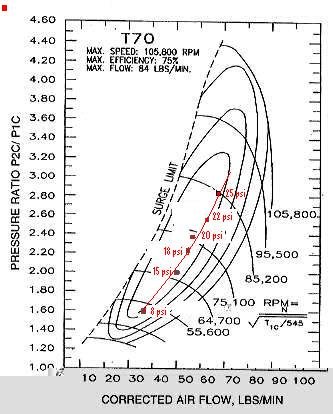Lextreme II
Just call me "Lex"
- Messages
- 12,033
- Location
- City of Halos
Here is the compressor map of T70 for the new turbo brand call Master Power.

Brand new! Perfect for extremely high HP engines. 0.70 A/R compressor housing. Super 70 Trim compressor wheel (flows more than 85 lbs/min). My goal is 15 psi. The T70 is running right in the island of the compressor map above. Therefore, this turbo is great between 8-27 psi. That mean lots of room for improvement. Why did i choose this turbo? I want this to be my last turbo. All I have to do is to upgrade internal parts to run the max. I also added dots for the compressor map so u can see where the effeciency located. Once again, this turbo is best runing from 15 psi to 22 psi. However, for the 4.0 liter, 20 psi is the most effecient working condition for the turbo. At 20 psi, its in the middle of the island. The red highlight is the airflow for the 1uzfe 4.0 engine. You can trace along the red line and see the boost level and horse power produced.
Here is the formula:
1UZFE Displacement = 4.0 liters = 244.09 cubic inches
Air flow equals: Cid X RPM X 0.5 X Ev divided by 1728
For 6500 redline and Ev = 0.80:
Air flow equals: 244.09.07 X 6500 X 0.5 X 0.80 = 367.26cfm divided by 1728
1lb/min = 14.472 cfm
so 367.26cfm = 25.37 lbs/min
air flow at boost = stock air flow X pressure ratio
Pressure Ratio = (boost + 14.7) divided by 14.7
So for 15psi of Boost @ 6500rpm:
Air flow = 367.26 X (15+14.7) = 742.01cfm or 51.27lbs/min divided by 14.7
Look for those compressor map with the above value and 51.27lbs/min
With the link below, you can compare pressure level with airflow in the uzfe engines. Here is a spread sheet on boost level with different UZFE engines.
Here are other compressor map of MP turbos
Master Power 60-1/62-1 Turbos

Master Power T61/T62 Turbos

Anyone can explain if this turbo is good for the 1uzfe? The price and quality is very attractive.

Brand new! Perfect for extremely high HP engines. 0.70 A/R compressor housing. Super 70 Trim compressor wheel (flows more than 85 lbs/min). My goal is 15 psi. The T70 is running right in the island of the compressor map above. Therefore, this turbo is great between 8-27 psi. That mean lots of room for improvement. Why did i choose this turbo? I want this to be my last turbo. All I have to do is to upgrade internal parts to run the max. I also added dots for the compressor map so u can see where the effeciency located. Once again, this turbo is best runing from 15 psi to 22 psi. However, for the 4.0 liter, 20 psi is the most effecient working condition for the turbo. At 20 psi, its in the middle of the island. The red highlight is the airflow for the 1uzfe 4.0 engine. You can trace along the red line and see the boost level and horse power produced.
Here is the formula:
1UZFE Displacement = 4.0 liters = 244.09 cubic inches
Air flow equals: Cid X RPM X 0.5 X Ev divided by 1728
For 6500 redline and Ev = 0.80:
Air flow equals: 244.09.07 X 6500 X 0.5 X 0.80 = 367.26cfm divided by 1728
1lb/min = 14.472 cfm
so 367.26cfm = 25.37 lbs/min
air flow at boost = stock air flow X pressure ratio
Pressure Ratio = (boost + 14.7) divided by 14.7
So for 15psi of Boost @ 6500rpm:
Air flow = 367.26 X (15+14.7) = 742.01cfm or 51.27lbs/min divided by 14.7
Look for those compressor map with the above value and 51.27lbs/min
With the link below, you can compare pressure level with airflow in the uzfe engines. Here is a spread sheet on boost level with different UZFE engines.
Here are other compressor map of MP turbos
Master Power 60-1/62-1 Turbos

Master Power T61/T62 Turbos

Anyone can explain if this turbo is good for the 1uzfe? The price and quality is very attractive.
